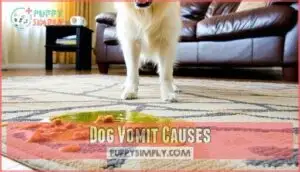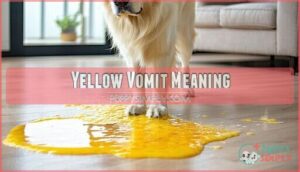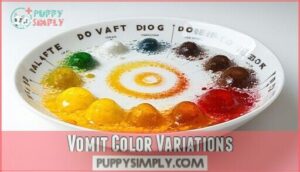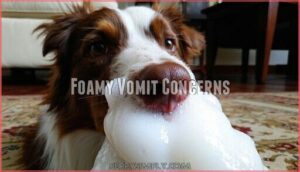This site is supported by our readers. We may earn a commission, at no cost to you, if you purchase through links.
 Your dog’s vomit color can reveal important health clues.
Your dog’s vomit color can reveal important health clues.
Yellow or white vomit often indicates bile or an empty stomach, while red suggests bleeding that needs immediate attention.
Green vomit points to bile or eaten grass, and brown could be from digested blood or eating feces.
Foamy white vomit typically means stomach acid, and black "coffee ground" vomit signals digested blood—an emergency situation.
Clear vomit usually results from water consumption or excess saliva.
When in doubt, note the color, consistency, and frequency of your pet’s vomiting, as the difference between harmless stomach upset and something serious often comes down to these colorful details.
Table Of Contents
- Key Takeaways
- Dog Vomit Causes
- Vomit Color Guide
- Treating Dog Vomit
- Vomit Color Variations
- Dog Vomit Consistency
- Emergency Vomit Signs
- Vomit Vs Regurgitation
- Vomit Color Emergency
- When to See Vet
- Frequently Asked Questions (FAQs)
- What color of throw up is bad for dogs?
- What color is pancreatitis dog vomit?
- What color is dog vomit with intestinal blockage?
- What are the concerning colors of vomit?
- What is the best way to prevent dog vomiting?
- How can I make my dog more comfortable if they are vomiting?
- Is it necessary to take a sample of my dog’s vomit for testing?
- Are there any home remedies I can use to treat dog vomiting?
- Why does my dog vomit after drinking water?
- Is seasonal vomiting normal in dogs?
- Conclusion
Key Takeaways
- Keep an eye on your dog’s vomit color—red, black, or dark brown point to serious issues like blood or internal bleeding and need immediate vet attention.
- Yellow or green vomit often ties to bile or grass ingestion, while white foam signals stomach acid or an empty stomach.
- Vomit consistency matters—chunky vomit suggests undigested food or blockages, while clear or liquid vomit could mean hydration issues.
- Always act fast if vomiting persists, includes blood, or is paired with weakness to prevent dehydration or underlying health complications.
Dog Vomit Causes
Your dog’s vomiting can stem from various issues including dietary indiscretions, ingestion of foreign objects, or underlying health conditions like pancreatitis or kidney disease.
You’ll need to take into account both what your pet ate recently and their overall health when determining why your furry friend suddenly redecorated your carpet with vomiting.
Economic Opportunities Abroad
When discussing dog vomit causes, think of it like exploring global marketplaces: just as foreign investments or overseas ventures bring opportunity, a dog’s new food or treat can disrupt their system.
Whether it’s from international trade in exotic snacks or export strategies in dietary changes, understanding the vomit color chart helps.
Treat dog vomiting swiftly to avoid complications, and remember that dog vomiting can be caused by various factors, including new food.
Globalizations Environmental Impact
Globalization’s environmental effects may seem unrelated, but they can contribute to dog vomit causes, like toxin ingestion from pollution export or deforestation impact.
Climate change can disrupt food sources, leading to gastrointestinal issues.
Monitoring your dog’s health through a vomit color guide or vomit color chart helps spot problems early.
A sustainable trade approach may minimize carbon footprint-related risks.
Cultural Exchange Benefits
Understanding your dog’s vomit color can feel like decoding a riddle, but it’s key for their health.
Global understanding of dog vomit meaning helps you respond better.
Think of:
- Yellow bile signaling an empty stomach.
- Green from grass, common and harmless.
- Red indicating blood, requiring action.
- White foam suggesting mild reflux.
This vomit color guide equips you for better care.
Vomit Color Guide
Understanding the color of your dog’s vomit can give you important clues about their health.
Each color has a unique meaning, helping you decide whether it’s a minor issue or something that needs a vet’s attention.
Yellow Vomit Meaning
Yellow dog vomit is often linked to bile vomiting from an empty stomach or acid reflux.
Bile, created in the liver, can irritate the stomach lining. Adjusting meal frequency may help.
However, persistent yellow vomit could signal liver issues or bile-related problems. If you notice specks of blood, it’s vital to seek immediate veterinary attention.
Follow this dog vomit color guide: monitor closely and contact your vet if it doesn’t resolve.
White Vomit Implications
Ever wondered why your pup has white, foamy vomit? It could mean bilious vomiting syndrome or an empty stomach.
Watch for serious issues like pancreatitis, kidney problems, or foreign objects. Keep this dog vomit guide handy to identify concerns.
Here’s what white dog vomit might hint at:
- Foamy Vomit: Stomach acid mix
- Pancreatitis Sign
- Bloat Link
- Kidney Issues
- Foreign Objects
Red Vomit Concerns
Red vomit often signals blood, a sign of esophageal bleeding, ulcers, or internal trauma. It might also stem from blood consumption (like a nosebleed) or red dye in food.
Bright red indicates recent bleeding, while darker shades suggest internal bleeding or stomach irritation. Seek help quickly!
Treating Dog Vomit
When your dog vomits, knowing how to respond can make all the difference.
From simple fasting to natural remedies and over-the-counter options, you’ve got tools to help your pup feel better quickly.
Fasting and Hydration
When dealing with dog vomit, start by fasting your pup for 12-24 hours to let their stomach settle.
Keep them hydrated using small amounts of water or electrolyte solutions, as dehydration is a concern. Monitor dehydration signs like dry gums or lethargy.
Gradual reintroduction of food is key. For dog dehydration solutions, various products are available.
If vomiting persists, consult a vet for professional dog vomit treatment.
Natural Remedies
When dog vomiting strikes, natural remedies can help.
Ginger for nausea is a popular choice, offering a soothing effect.
Probiotic benefits include improved digestion and gut health for faster recovery.
Herbal remedies like chamomile tea may calm the stomach.
Considering ginger products for dogs can be a helpful option.
As a fasting alternative, try small bland meals.
Always observe your dog’s health closely and consult a vet if vomiting continues, using natural remedies and monitoring for improved gut health.
Over-the-Counter Medications
After exploring natural remedies, let’s look at over-the-counter options for dog vomit treatment.
Medications like omeprazole or famotidine can help reduce stomach acid, but always follow dosage guidelines. Consider appropriate omeprazole products for your dog.
Watch for side effects or medication interactions. Safe usage means consulting your vet first.
If OTC remedies don’t help, explore alternative options. Dog vomit color changes may need professional care.
Vomit Color Variations
Dog vomit comes in a wide range of colors, each offering clues about your pet’s health.
By understanding these variations, you can better identify when it’s time to call the vet or simply adjust your dog’s routine.
Green Vomit Causes
Spotting green dog vomit can be puzzling, but it’s often tied to diet or digestion issues.
Green dog vomit often reveals your pet’s dietary adventures or signals a digestive system in distress.
Common causes include:
- Grass ingestion: Dogs nibble grass; it irritates their stomach.
- Bile reflux: Indicates an empty stomach or acid buildup.
- Liver issues: Disrupted digestion releases bile.
- Gallbladder issues: Improper bile drainage causes green vomit.
- Diet-related: Foods or toxins affect digestion and color.
Brown Vomit Implications
Brown dog vomit can mean several things based on the dog vomit color guide. It might match kibble color or result from feces ingestion.
However, it could signal serious issues like digested blood or an intestinal blockage, which are serious. Pay attention to dietary factors and symptoms.
Use the table below for insights:
| Cause | Appearance | Seriousness | Action |
|---|---|---|---|
| Kibble Color | Brown, food-like | Low | Monitor for changes |
| Feces Ingestion | Dark brown, foul smell | Moderate | Consult if persistent |
| Digested Blood | Coffee ground-like brown | High | Seek vet immediately |
| Intestinal Blockage | Dark, foul, or sticky | High | Emergency care needed |
The table provides a clear overview of the possible causes of brown dog vomit, including kibble color, feces ingestion, digested blood, and intestinal blockage. Each cause has a distinct appearance, level of seriousness, and recommended action.
Black Vomit Concerns
Black vomit often signals serious issues like digested blood or internal bleeding. It might also indicate ulcer signs, toxin ingestion, or poisonous substances.
Here’s a short, engaging blockquote in the same tone as the paragraph:
Black vomit sounds the alarm—digested blood or toxins demand immediate action before serious damage occurs.
Watch for these warning signs:
- Coffee ground-like vomit suggests coagulated blood.
- Accompanying weakness or pale gums signals emergencies.
- Persistent vomiting or abdominal pain needs vet action.
- Immediate emergency actions for possible poisonous ingestion.
Dog Vomit Consistency
When your dog vomits, the consistency can offer important clues about what’s going on inside their stomach.
Understanding whether it’s chunky, liquid, or foamy helps you figure out if it’s a quick fix or something that needs a vet’s attention.
Chunky Vomit Meaning
Chunky vomit often points to undigested food, foreign material, or partially digested meals.
Size matters when evaluating chunks—larger pieces suggest quick vomiting, while smaller ones may hint at digestion issues.
Pay attention to severity levels; consistent chunky vomit can signal dietary problems or blockages.
Understanding dog vomit consistency helps determine if it’s time for a vet visit.
Liquid Vomit Implications
When your dog produces liquid vomit, it often signals different health concerns than chunky vomit.
This watery consistency typically indicates:
- An empty stomach causing acid reflux
- Excessive water consumption too quickly
- Early signs of infection or illness
- Digestive system irritation
- Possible medication side effects
Clear liquid vomit usually means your dog’s stomach is empty, while cloudy liquid might indicate developing issues.
Note dog vomit color for identifying potential underlying issues.
Don’t ignore repeated episodes of liquid dog vomit, as dehydration can develop rapidly.
Foamy Vomit Concerns
When your dog produces foamy vomit, it often indicates trapped air or gas in their digestive system.
This consistency deserves your attention as it may signal several underlying conditions.
| Foamy Vomit Cause | What It Means |
|---|---|
| Acid reflux | Dog’s stomach acids flowing back up |
| Empty stomach | Bilious vomiting syndrome |
| GI irritation | Inflammation from food or allergens |
| Toxin ingestion | Reaction to harmful substances |
Diagnostic tests may be needed if frequency matters – occasional foam is less concerning than recurring episodes.
Regular veterinary visits can help address common pet issues that may be the cause.
Emergency Vomit Signs
You’ll need to recognize certain vomit signs that require immediate veterinary attention, including blood in vomit, frequent episodes, or signs of toxin ingestion.
When your dog displays these emergency symptoms, don’t wait to see if they improve on their own as prompt medical care can be the difference between a quick recovery and serious complications.
Blood in Vomit
Finding blood in your dog’s vomit is always a serious emergency sign.
Fresh blood appears bright red, while digested blood looks like coffee grounds or has a dark appearance.
This bloody dog vomit can indicate ulcers, internal bleeding, or stomach damage.
Don’t wait – contact your vet immediately when you spot any red vomit containing blood.
The ulcer risk increases with certain medications and stress factors.
Frequent Vomiting
When your dog is frequently throwing up, it’s a clear warning sign that shouldn’t be ignored.
Chronic vomiting often indicates underlying conditions requiring prompt attention. Multiple episodes within 24 hours can lead to serious dehydration risks, necessitating immediate veterinary care.
Your vet may recommend diagnostic tests to determine the root cause and suggest dietary adjustments accordingly. Don’t wait—frequent dog vomit episodes warrant professional evaluation regardless of color, as they may indicate a need for immediate veterinary care.
Toxin Ingestion
During toxin ingestion, your dog’s vomit often serves as the first warning sign of poisoning. Watch for changes in vomit color, which may indicate exposure to harmful substances.
- Common toxins include chocolate, medications, plants, and household chemicals
- Symptoms include vomiting, diarrhea, drooling, and behavioral changes
- Immediate action is vital – contact your vet or pet poison hotline right away
- Collect a sample of the vomit and any suspected toxin for veterinary diagnosis to ensure immediate action.
Vomit Vs Regurgitation
You’ll need to know the difference between vomiting and regurgitation to properly address your dog’s health concerns.
Vomiting involves active abdominal contractions and typically brings up partially digested food, while regurgitation happens passively when undigested food comes back up from the esophagus without warning, which can be related to regurgitation.
Vomiting Definition
After spotting those emergency signs, you’ll want to understand what’s actually happening when your dog vomits.
True vomiting is an active process where your dog’s body forcefully expels stomach contents.
You’ll typically see your dog heaving several times before the actual vomit appears.
The behavior associated with vomiting can be an important indicator of what is happening, including nausea signs before expulsion.
| Vomiting Characteristics | What You’ll Notice | What It Means |
|---|---|---|
| Abdominal retching | Visible stomach contractions | Active expulsion force |
| Vomit composition | Partially digested food | Stomach contents |
| Behavior | Nausea signs before expulsion | Triggered vomiting reflex |
Regurgitation Definition
Unlike vomiting, regurgitation happens when undigested food returns from the esophagus without stomach acid or bile.
It’s a passive process where food simply comes back up shortly after eating.
| Regurgitation Types | Common Causes | Warning Signs |
|---|---|---|
| Immediate | Megaesophagus | Food shaped like tubes |
| Delayed | Esophageal stricture | No retching before episode |
| Partial | Foreign body | Undigested food appearance |
You’ll notice regurgitation lacks the forceful heaving associated with dog throwing up, which is a key difference between the two, and undigested food can be a clear indicator of this condition, often appearing as tubes.
Key Differences
Now that you understand regurgitation, let’s examine the key differences between vomiting and regurgitation in dogs.
You can tell them apart by looking at timing, appearance, and effort. Vomiting involves active abdominal contractions and often produces bile, while regurgitation happens passively without warning.
| Feature | Vomiting | Regurgitation |
|---|---|---|
| Timing | After digestion begins | Shortly after eating |
| Appearance | Contains bile, may be yellow | Undigested food, tube-shaped |
| Effort | Active, with retching | Passive, no warning |
Vomit Color Emergency
You’ll need to act immediately if you notice red, black, or dark brown vomit from your dog as these colors indicate blood or digested blood requiring emergency veterinary care.
Certain vomit colors serve as warning signals that shouldn’t be ignored, particularly when accompanied by pale gums, weakness, or persistent vomiting.
Red Vomit Action
When you discover red vomit from your dog, act immediately as this indicates blood and requires urgent veterinary care.
The amount of blood can signal different underlying causes, from minor irritation to severe ulcers. Don’t wait for symptoms to worsen—call your vet right away for diagnostic tests and treatment options.
Red vomit is one of the most serious emergency situations in any dog vomit color guide. This could be caused by stomach ulcers or other serious issues.
Black Vomit Action
Black dog vomit needs emergency veterinary care. This coffee ground-like appearance typically signals internal bleeding or poisonous ingestion.
When you notice black vomit, take these immediate actions:
- Don’t induce further vomiting
- Save a sample for diagnostic tests
- Keep your dog calm and warm
- Go to an emergency vet immediately
Prognosis factors depend on the underlying cause and how quickly you seek help.
Dark Brown Vomit Action
Dark brown vomit in your dog often resembles coffee grounds and requires immediate action, just like black vomit.
This coloration typically indicates digested blood, intestinal blockage, or severe GI issues.
If you notice dark brown dog vomit, follow these steps:
- Don’t wait to observe – seek immediate vet care
- Check for signs of feces ingestion
- Look for other symptoms of internal bleeding
- Collect a sample for testing
- Keep your dog calm during transport to prevent further internal bleeding
When to See Vet
You’ll need to contact your veterinarian immediately if your dog’s vomiting persists for more than 24 hours, contains blood, or is accompanied by weakness, lethargy, or abdominal swelling.
Don’t wait to seek help if your dog vomits material resembling coffee grounds or has black vomit with pale gums, as these signs indicate potential internal bleeding that requires urgent medical attention, which may involve internal bleeding.
Persistent Vomiting
While emergency vomit colors signal immediate action, persistent vomiting demands veterinary attention regardless of color.
If your dog has thrown up multiple times within 24 hours, they’re facing serious dehydration risks. Your vet will explore underlying causes through diagnostic options like bloodwork or imaging.
Don’t wait—prolonged vomiting can have long-term effects on your dog’s health. Proper treatment plans typically address both symptoms and root causes of dog vomiting.
Vomit With Blood
Any vomit containing blood requires immediate veterinary attention.
Fresh blood appears bright red, while digested blood resembles coffee grounds.
Both indicate serious issues like ulcers, HGE signs, or internal bleeding.
Don’t wait to see if it resolves—this isn’t normal dog throwing up.
One potential cause could be stomach ulcers from acid.
Your quick action could save your pet’s life.
Different dog vomit colors tell different stories, but red vomit always means emergency care.
Vomit With Weakness
While blood in your dog’s vomit signals internal issues, vomiting paired with weakness requires immediate veterinary attention.
If your pup struggles to stand, seems unusually tired, or collapses after vomiting, don’t wait.
These lethargy signs often indicate dehydration risk, muscle weakness, neurological issues, or even organ failure.
When your normally energetic companion becomes listless alongside vomiting, it’s your cue to call the vet right away.
Frequently Asked Questions (FAQs)
What color of throw up is bad for dogs?
Did you know some vomit colors in dogs signal emergencies?
Watch out for red, black, or "coffee ground" vomit—these may mean internal bleeding.
Blue or purple could point to toxins.
Call your vet immediately.
What color is pancreatitis dog vomit?
Pancreatitis in dogs often causes white, foamy vomit or yellow bile, especially if the stomach is empty.
It’s usually paired with other symptoms like abdominal pain or lethargy, so always check with your vet.
What color is dog vomit with intestinal blockage?
When your dog has an intestinal blockage, vomit might appear brown with a foul smell or resemble "coffee grounds," indicating digested blood.
Colors like yellow or green may also show up due to bile.
What are the concerning colors of vomit?
Imagine striking colors in a troubling scene: red, black, or dark brown vomit can signal blood or internal bleeding.
Blue or purple hints at toxin ingestion.
Any of these should prompt an immediate vet visit.
What is the best way to prevent dog vomiting?
Feed your dog a consistent, balanced diet, avoid table scraps or garbage, and prevent access to toxins.
Slow their eating with puzzle feeders.
Regular veterinary checkups help catch health issues early, keeping vomiting at bay, which is crucial for maintaining your dog’s overall health through regular checkups.
How can I make my dog more comfortable if they are vomiting?
When your pup’s tummy is on strike, give them a cozy spot to rest and fresh water nearby.
Skip meals for 6-12 hours, then ease in with plain boiled chicken and rice.
Is it necessary to take a sample of my dog’s vomit for testing?
Yes, taking a sample can help your vet identify the cause of vomiting.
Use a clean bag or container, store it cool, and bring it along.
It’s gross, but it’s helpful!
Are there any home remedies I can use to treat dog vomiting?
When your dog’s stomach does flips like an old VCR rewind, try fasting them for 6-12 hours.
Offer small bland meals like boiled chicken and rice, and make certain they’re drinking water to stay hydrated.
Why does my dog vomit after drinking water?
Your dog might vomit after drinking water because they’re gulping it too fast, irritating their stomach.
It could also signal an empty stomach, acid reflux, or a more serious issue like gastritis—monitor closely.
Is seasonal vomiting normal in dogs?
Think of vomiting as your dog’s internal alarm clock.
Seasonal vomiting isn’t typical, but allergies, diet changes, or environmental shifts may trigger it.
Monitor patterns, and if it persists, check with your vet.
Conclusion
Did you know nearly 70% of dogs experience vomiting at least once a year.
Understanding the color and consistency can help you spot serious issues early. This dog vomit color guide highlights key health clues, from harmless yellow bile to emergency signs like black or red vomit.
Keep an eye on your dog’s symptoms, and don’t hesitate to consult a vet if needed. A quick response could make all the difference for your furry friend’s health.
A quick response could be crucial in such situations.



















